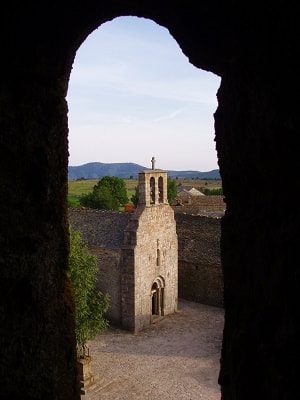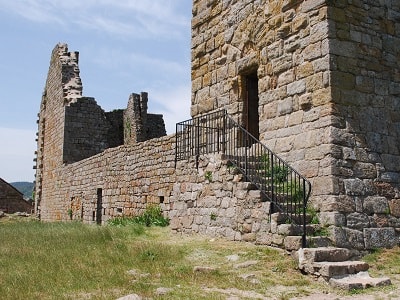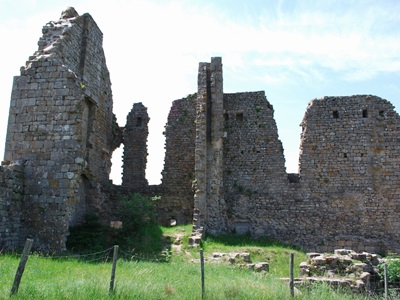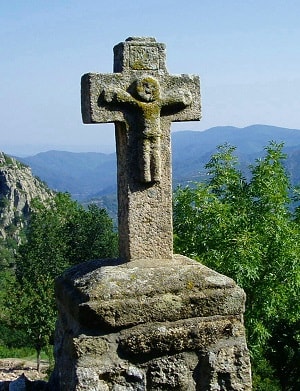

|
The castle, as it stands today, includes the terrace at the base of the tower and the ruins of the Molette de Morangies residence. |


 The Great Hours of La Garde-Guerin
The Great Hours of La Garde-Guerin
The bishops of Mende held a privilege known as the “feudal withdrawal.” In the event of a vassal selling their fief, the bishops had the right to exclude the buyer by reimbursing the price. In 1334, they were allowed to maintain this privilege even as the consuls asserted their claim to the same right before the seneschal of Nîmes. As a result, the lords received less and less money.
The consuls of La Garde requested permission from the King of France to establish a fair, emphasizing the benefits it would bring to the three dioceses of Mende, Uzes, and Viviers. Louis d’Anjou, Count of Maine and the second son of the French king, Charles V, granted La Garde-Guerin a fair on November 25, the feast day of Saint Catherine, as well as a weekly market on Mondays. The fair was to last for three consecutive days.
 This agreement dates back to January 22, 1367. Under royal authority, the officers of the Common Court of Gevaudan were forbidden, under penalty of 500 marks of fine silver, from disturbing the inhabitants of La Garde-Guerin in the enjoyment of the privilege granted to them. Thus, the fair was established in La Garde by royal decree and under the protection of the bishops. From then on, La Garde-Guerin gained commercial significance. People would stop there and experience the joys of the fair and accompanying festivities for at least three days. Even today, the “Pre de la Foire” (Fair Meadow) is spoken of, located to the left as you arrive in the village.
This agreement dates back to January 22, 1367. Under royal authority, the officers of the Common Court of Gevaudan were forbidden, under penalty of 500 marks of fine silver, from disturbing the inhabitants of La Garde-Guerin in the enjoyment of the privilege granted to them. Thus, the fair was established in La Garde by royal decree and under the protection of the bishops. From then on, La Garde-Guerin gained commercial significance. People would stop there and experience the joys of the fair and accompanying festivities for at least three days. Even today, the “Pre de la Foire” (Fair Meadow) is spoken of, located to the left as you arrive in the village.
A Hospital for Pilgrims and Travelers The existence of a hospital is mentioned in ancient records. On the cadastral map from 1812, there is a plot called the “Ancien Hôpital (Pre de la Justice)” (Old Hospital - Meadow of Justice) outside the village, beyond the ramparts, not far from the Saint-Michellemont Gate.
During the Middle Ages, hospitals located at the gates of cities or villages were meant to accommodate and shelter travelers, pilgrims, and the destitute, providing them with care. In France, most pilgrim hospitals were founded between the 11th and 12th centuries. The La Garde hospital likely welcomed travelers caught in storms, tempests, or harsh climates on this windswept plateau. Perhaps it also hosted pilgrims en route to Saint-Jacques de Compostelle. The paths of Saint-Jacques were not far away, whether coming from Le Puy-en-Velay or Carcassonne, and the unwavering fervor of medieval men inspired many to take the journey.
Let us recall that the Regordane route led pilgrims to Saint-Gilles in Gard; the former priory of Prevencheres was indeed dependent on the Abbey of Saint-Gilles. The maintenance costs of this hospital were covered by various revenues from the paper community. By the end of the 14th century and into the 15th century, new families acquired shares and settled in La Garde-Guerin. During the 14th century, the shares frequently changed hands, and the old shareholders, with the exception of a very small number, eventually disappeared. Only a few members remained. It has a rich history: in 1569, the Bishop Count of Gevaudan, Renaud de Beaune, sold his shares of La Garde-Guerin to the lords of Morangies. The noble consul positions in La Garde-Guerin remained within the Molette de Morangies family until the French Revolution. Despite this, the bishops retained high jurisdiction and the “major” domain. During the Wars of Religion, the castle, due to its strategic position, played a significant role. The Catholics defended it, but it was captured by the Protestants. Antoine de Molette, Lord of Morangies and defender of La Garde-Guerin, met a glorious end, fighting valiantly. The castle was eventually taken, and the village suffered partial destruction by fire.
It has a rich history: in 1569, the Bishop Count of Gevaudan, Renaud de Beaune, sold his shares of La Garde-Guerin to the lords of Morangies. The noble consul positions in La Garde-Guerin remained within the Molette de Morangies family until the French Revolution. Despite this, the bishops retained high jurisdiction and the “major” domain. During the Wars of Religion, the castle, due to its strategic position, played a significant role. The Catholics defended it, but it was captured by the Protestants. Antoine de Molette, Lord of Morangies and defender of La Garde-Guerin, met a glorious end, fighting valiantly. The castle was eventually taken, and the village suffered partial destruction by fire.
In the 17th century, La Garde-Guerin remained one of the most important landmarks in the diocese. In 1623, during the Estates General of Gevaudan, where the two consuls sat, a sum of 400 livres was imposed for maintaining the garrison and the castle of La Garde-Guerin. The Marquis de Portes, Governor of Gevaudan, ensured the village’s safety. As described in the life of the Duke of Montmorency, La Garde-Guerin was “a castle that guards the passage of the Cevennes on one side and defends the mountain against any rebel incursions. The well-being of Gevaudan and Velay partly depends on the preservation of this place.” Many ancient fortresses crumbled during Louis XIV’s reign, and La Garde-Guerin rarely saw its masters. It was left under the watchful eye of farmers, and it tragically burned down in 1722.
 In 1721, the fair was moved to Saint-Michel, which falls on September 29th. Saint-Michel was indeed the patron saint of the village.
In 1721, the fair was moved to Saint-Michel, which falls on September 29th. Saint-Michel was indeed the patron saint of the village.
In 1745, during the Battle of Fontenoy, many English and French nobles lost their lives. Among them were the lords of La Garde. The lords of Morangies took the place of the noble consuls of La Garde-Guerin in the Estates of the Diocese of Mende. This was all that remained of the privileges of the ancient association of bettors.
On August 4, 1789, the revolutionaries abolished these privileges, including the rights of the bettors of La Garde.
In 1795, one of the sturdy towers, attached to the castle, collapsed onto a house in the village, causing deaths and injuries. The village then definitively turned towards agriculture, and the fair persisted.
Under the protection of Saint-Michel, the current ramparts hint at the historical significance of the place. These fortifications once encircled both the castle and the village. They were likely built in the 12th century, after the castle itself. Access was through two gates: one, called the “Rachas,” located to the north, opened onto the main cobbled street. The other, to the south, was named the “Porte Saint-Michellemont.” The ramparts were constructed using beautiful local stones—rectangular sandstone blocks—carefully cut from a nearby quarry. The facing stones are remarkably solidly connected. Judging from the preserved but now decrowned sections, their height likely reached 8 to 10 meters. The average thickness of the walls, both externally and internally, is approximately 1.65 meters.
 On these ramparts, no traces of battlements, towers, or watchtowers remain visible, although they might have existed. In certain places, the walls still stand at a height of 6 meters, particularly on the western side. The remnants of the ditches that surrounded the ramparts can still be seen on the village plan.
On these ramparts, no traces of battlements, towers, or watchtowers remain visible, although they might have existed. In certain places, the walls still stand at a height of 6 meters, particularly on the western side. The remnants of the ditches that surrounded the ramparts can still be seen on the village plan.
The path that runs along the base of the ramparts, to the southwest, is called “Ancien Fosse Lou Ballat” (Old Ditch Lou Ballat). These ditches were primarily dug there to increase the difficulties faced by attackers. To the east, where the walls were built directly on the cliffs overlooking the Chassezac gorges, there were no ditches. The castle stood to the northeast of the village, in the highest, least accessible, and most defensible location. It’s challenging to imagine what it might have been like. Today, only a square tower, standing at 21.50 meters, remains—a testament to the significance of the vanished castle.
 In the book “Images du Patrimoine Canton de Villefort-Lozere,” published in 1989, we find the following description of the tower and the remnants of the lord’s residence: “The Tower of La Garde-Guerin is, in fact, the medieval keep of the castle. It was square in plan and had five levels. The ground floor is blind, accessible only through a trapdoor opening into the vaulted semi-circular ceiling of the first floor. The entrance door is located at this level. The external staircase used by visitors is, of course, a recent addition. Two other floors, also vaulted with semi-circular arches, served as living quarters. The rooftop terrace likely remains from a lost upper floor, although ancient restorations have altered its appearance. The machicolation’s crowning feature was reconstructed using a few original elements.”
In the book “Images du Patrimoine Canton de Villefort-Lozere,” published in 1989, we find the following description of the tower and the remnants of the lord’s residence: “The Tower of La Garde-Guerin is, in fact, the medieval keep of the castle. It was square in plan and had five levels. The ground floor is blind, accessible only through a trapdoor opening into the vaulted semi-circular ceiling of the first floor. The entrance door is located at this level. The external staircase used by visitors is, of course, a recent addition. Two other floors, also vaulted with semi-circular arches, served as living quarters. The rooftop terrace likely remains from a lost upper floor, although ancient restorations have altered its appearance. The machicolation’s crowning feature was reconstructed using a few original elements.”
The bossage technique, unique in the region and made of sandstone, dates back to either the 11th or 12th century. At the base of the tower, you can see the remnants of the lord’s residence. This long rectangular building, with a spiral staircase tower on the facade, was destroyed by fire in 1722. Archaeological surveys are ongoing to create an accurate plan of its structures and refine its dating. To date, the archaeologists’ conclusions suggest construction in the late 16th century. The marquise de Morangies still inhabited it at the end of the 17th century.
Beneath the ground floor of the lord’s residence, you can observe vaulted rooms that likely served as storage, food storage, dungeons, or oubliettes. These rooms, filled in after the castle fire, have been cleared and restored, with ongoing restoration efforts. A few meters from the tower stand a bread oven and a 12-meter-deep well, hewn into the rock. At the bottom of this well flowed a meager spring, contributing to the castle’s resilience.
Beneath the meadow where the castle was built, locals say there are numerous vaulted rooms. These hidden chambers lie beneath the surface.
 Not far from the tower, to the east, stands a beautiful Romanesque church dedicated to Saint Michael, the patron saint of the knightly bettors. Inside the church, on the triumphal arch, you’ll find a gilded and painted wooden statue of Saint Michael. In this depiction, Saint Michael triumphs over the demon, standing proudly with his victim slightly behind him. His right arm is raised, leaning on his long lance, while his left arm points downward, indicating the defeated demon. The statue dates back to the 15th century.
Not far from the tower, to the east, stands a beautiful Romanesque church dedicated to Saint Michael, the patron saint of the knightly bettors. Inside the church, on the triumphal arch, you’ll find a gilded and painted wooden statue of Saint Michael. In this depiction, Saint Michael triumphs over the demon, standing proudly with his victim slightly behind him. His right arm is raised, leaning on his long lance, while his left arm points downward, indicating the defeated demon. The statue dates back to the 15th century.
Originally, this church served as the chapel of the castle. The construction of a castle was often accompanied, as early as the 11th century, by the establishment of one or more sanctuaries. These sanctuaries, whether located inside or outside the castle walls, were intended to commemorate religious events, honor saints or relics, and facilitate the devotions of the lord and his men. Acts of generosity toward these sanctuaries and the devotional practices associated with them contributed to strengthening the social cohesion of the group formed by the lord, his family, and all those who lived under his protection, sharing a common piety toward a saint.
 The nave’s vault, constructed with cut stones, forms a barrel vault. In the middle of the nave and the apse, a prominent double arch supports the vault and rests on the pillars. The sculpted capitals add richness and grace. The columns are all separate from the pilaster, sometimes even superimposed, as seen in other Romanesque churches in the southeastern part of France.
The nave’s vault, constructed with cut stones, forms a barrel vault. In the middle of the nave and the apse, a prominent double arch supports the vault and rests on the pillars. The sculpted capitals add richness and grace. The columns are all separate from the pilaster, sometimes even superimposed, as seen in other Romanesque churches in the southeastern part of France.
The capitals, each unique, are adorned with foliage, flowers, animals, or enigmatic biblical figures. The tops of the column heads often feature billets or checkerboard patterns. The choir is embellished with harmonious arcades, slender columns, and simple capitals, allowing light to filter through the arched windows. Beneath the choir lies a small vault hewn into the rock—a sort of crypt where the Consuls of the Papiers de La Garde may have been interred.
The beautiful entrance portal of the church lightens an otherwise austere facade. Curved moldings, sculpted from massive stone, form the ramparts around a wrought iron tympanum, recalling the dedication to St. Michael the Archangel. Above the door, a Romanesque window allows a glimpse of evening light, and a two-arch bell gable—typical of many ancient bell towers—completes the gable wall. The church’s thick walls and narrow openings provide better insulation against the external cold, supporting the barrel vault of the nave with ease. The Presbytere (presbytery) adjoins the church’s apse, and its enclosing wall joins the northern elevation of the church. Some sections of the apse are visible inside the presbytery. It was constructed in the 19th century using elements from the ruined castle.
 The “Pan du Roi”
The “Pan du Roi”
The parier lords, who shared the castle and lordship of La Garde-Guerin, had built strong houses—perhaps in the 12th century—about which we know very little. Only the existence of ancient wells and their location within the village allows us to identify these houses. They never had shared walls, and the “Pan du Roi” separated them. This narrow alley, about thirty centimeters wide, served no practical purpose. However, the “Pan du Roi” ensured that there would never be any disputes over shared walls. Each owner remained master of their own property, and the property line passed between the houses.
The concept of the “Pan du Roi” existed in the medieval seigneurial domains and was a well-known practice that persisted in cities until the French Revolution. Even today, the “Pan du Roi” still separates many houses in the village, especially along the main streets. However, these houses likely bear little resemblance to those originally built by the parier lords in the Middle Ages.
Some beautiful houses in La Garde exhibit a pierced gable wall on the ground floor, with a simple or paired half-door, and an elegant cross-window on the upper floor. Two houses in the village feature a stone in their walls, bearing a coat of arms dated 1597. Other escutcheons display the arms of noble families who once resided in La Garde-Guerin.
Embedded upside-down in the wall of a severely dilapidated house, a stone bears an inscription whose first two lines can be deciphered: “Reparation faicte par Pierre Bertrand” (Repair carried out by Pierre Bertrand). The Bertrand family was one of the four parier lord families in the 11th and 12th centuries. Pierre Bertrand was likely one of their descendants. The spelling “faicte” suggests a date around the 16th or 15th century. Association G.A.R.D.E, La Garde-Guerin, 48800 Villefort.
Old romantic Hotel, L'Etoile Guest-House is a mountain retreat in the South of France. With a beautiful park along the Allier River, L'Etoile Guesthouse is located in La Bastide-Puylaurent between Lozere, Ardeche and Cevennes. Many hiking trails like GR®7, GR®70 Stevenson trail, GR®72, GR®700 Regordane way, Cevenol, GR®470 Allier river, Margeride. Many hiking loops. The right place to relax.
Copyright©gr-infos.com